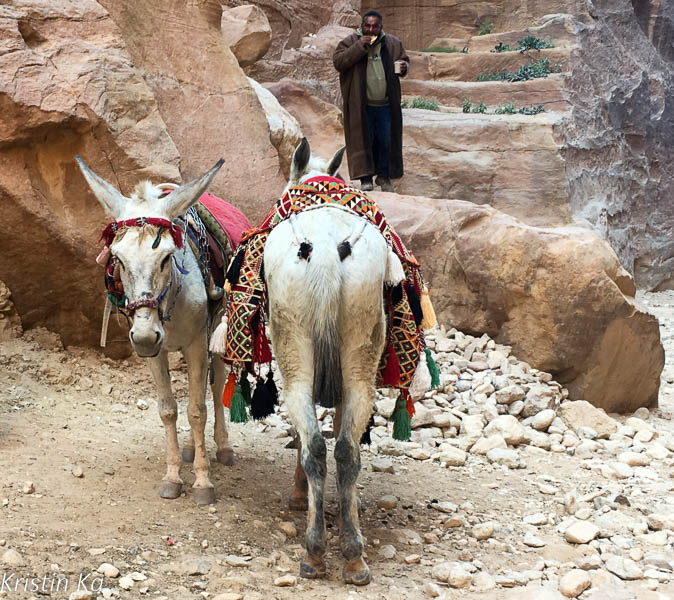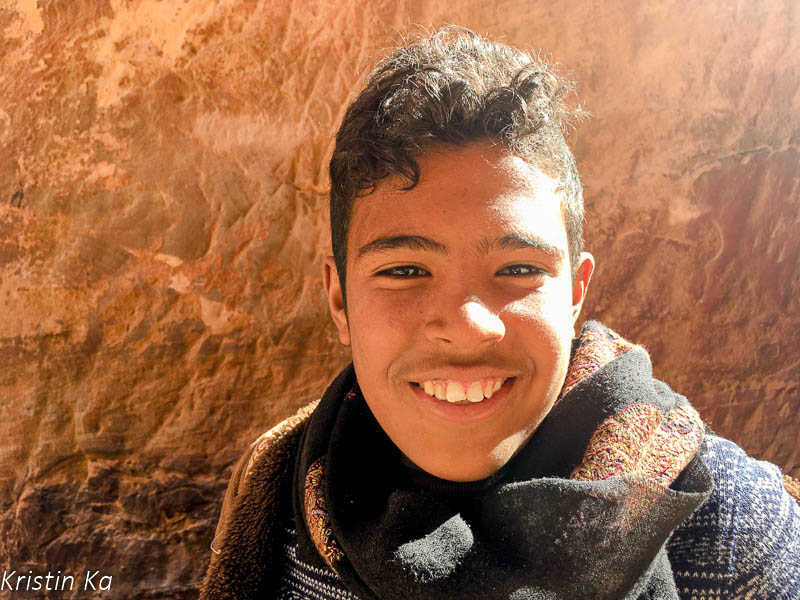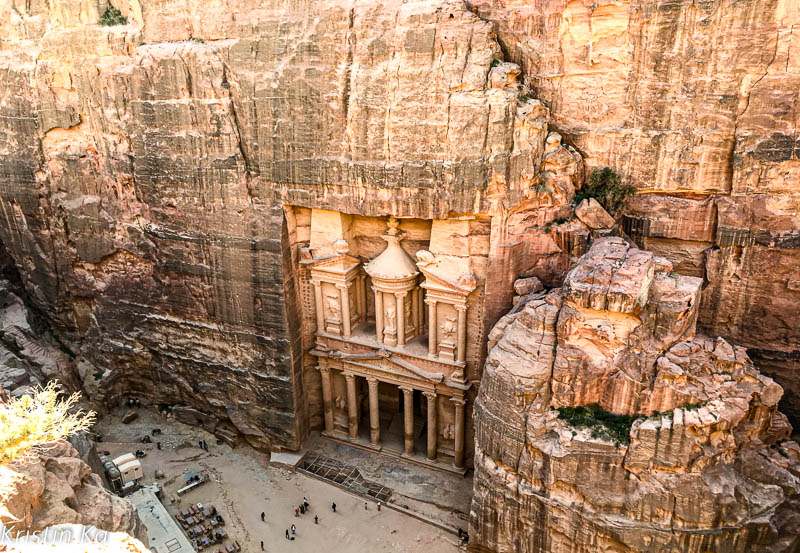Petra, pride of Jordan... we love it or we hate it. Why these extremes? The site is as beautiful as it is spoiled by tourism...
But why are travellers so divided about Petra?
Like all the beautiful places on this planet, tourists flock there. It is undeniable, Jordan’s flagship site has been transformed into a theme park. Nothing is missing: horse-drawn carriages, dromedaries harnessed with pompoms, silent donkeys, Bedouins disguised as Jack Sparrow.
Petra is Jordan’s Eiffel Tower. The place is over-exploited by the country in order to collect the fruits of mass tourism.
Every day, the pullman buses pour out their streams of passengers who visit the site in less than 4 hours. The programme includes a horse-drawn carriage ride, a camel ride or even a donkey ride up to the lookout.
Let’s see the few reasons to hate or love Petra. Everyone will have their own experience, let’s hope it will be beautiful!
Tourist harassment reaches its peak in Petra
To be contemplative for even a minute in Petra is pretty difficult
Whether dynamic or static, it is difficult to enjoy a minute’s silence. The demands are continuous, with every step on the floor, the visitor triggers a do you want buy something? or visit my shop! It’s as if the path is equipped with sensors that trigger automatic jingles.
Sitting down to enjoy the show in contemplation is just as difficult, the children, camel drivers and salesmen of all kinds are extremely sticky. The route requires a lot of energy, in addition to the 15/20 km to be covered, you have to keep answering questions. You have to force the roadblocks of the vendors or raiders, not rely on the deviations by the shop, refuse forced stops and stay concentrated so as not to trip over.
Petra’s shoplifters are experts at harassing tourists
The traveller will recognise the same manoeuvres as anywhere else: Luxor, Angkor, Marrakech or Taj Mahal. But in Petra one does in refinement. I have been accused of wanting to use both my legs rather than those of the donkeys. Because of me, he is going to die of hunger, because of my stubbornness not to use the services of the Bedouins, they are sinking into misery. Walking alone can be seen as a declaration of economic war or as a desire to inflict ill-treatment on the local population.
Not all Bedouins in Petra are real Bedouins. Most of them are just like the things they sell, fake
Firstly, real Bedouins do not disguise themselves as Caribbean pirates. The boys of Petra who cast languid Johnny Depp-like glances at you are willing to do anything to make a profit, even sell their charms to lonely travellers. They have nothing to do with the Petra natives who have inhabited the site for hundreds of years. All of them boast to the travellers that they are the real Bedouins of Petra, but 90% of them are wrong. They are not one lie short of a lie. I’ve seen them explain to Chinese tourists that the objects they sell are thousands of years old and 100% authentic…
The Bdouls of Petra: between tradition and modernity
This tribe of Petra, the Bdouls was properly evicted from the site when it was declared a World Heritage Site (1985). The government relocated the 150 bdouls families who lived there to move them further into permanent homes. Some of them remained, there are now less than 10 left, and it takes luck to meet them as they are so drowned in “copies”. Hospitality and benevolence are pillar values for these people, so it is a great pleasure to be able to share time with them. Unfortunately for some natives, and collaterally for visitors seeking an exchange, the economic transition has not taken place with good reason. Some have become masters at scams of every kind. So be careful on all levels.

We hate Petra because animals are mistreated and it’s unbearable
Horses, donkeys and camels, in Petra, the animals do not laugh every day
It’s a shame, an inhumanity. The Queen of Jordan, faced with PETA’s first alarming report, had rules against animal abuse introduced. Alas, as evidenced by the fact that they are not being followed.
It seems that introducing laws is totally useless. Abusers find it quite normal, one could say it is cultural in a way. And no law will change that. Change has to come through education and a strong will to change things. The owners oblige themselves, for fear of controls, not to exhaust the horses by letting them rest after two races. Alas, the animals are still mistreated with sticks and malnourished.
You will be told: animal abuse in Petra is due to tourism. This is not true
The local populations of the region have gone from a subsistence economy (sheep, goat and crop farming) to a tourist economy in 30/40 years. We are then told that this brutal transition makes things complicated and legitimises this animal slavery.
I don’t believe this, there is no reason to mistreat animals to the point of agony. Animals have been used in Jordan for thousands of years, but what is happening in Petra has nothing to do with animal husbandry, it is cruelty and stupidity. If it were really for a living, the owners would take care of their fellow workers in order to continue to provide for their common existence.
Animals are mistreated by morons who pursue only one goal: the lure of easy and quick gain. These people only see the short term and don’t care about preserving Bedouin traditions or Jordanian culture.
If the people working in Petra are unable to respect the non-negotiable animal welfare, visitors must unconditionally refuse to use the animals if they are not treated with respect.
If the people working in Petra are unable to respect the non-negotiable animal welfare, visitors must unconditionally refuse to use the animals if they are not treated with respect.
In Petra, animals are mistreated, but so are children too
Children are regularly exploited beyond what is bearable all over the world. They are sent to sell postcards or trinkets because they are capable of touching a traveller’s heart to make him untie his purse. The children of Petra do not go to school because they bring back money. They are not only exploited for financial gain, they are also subject to considerable physical and psychological violence. So be careful to find out before buying anything for them: by making their activity lucrative, the traveller with a tender heart will perhaps take away all the chances of these little ones going to school one day.
The best thing you can do sometimes is to spend a little time with them, really look at them and be kind to them. Telling them things that make them feel good, a compliment, a sincere word can sometimes be more helpful than a banknote.

So enough for the dark side of the Petra site, what if we ended up with the best that Petra has to offer?
To love Petra, disregard everything that irrational tourism brings with it and let yourself be captivated by the magic that the Nabataean site exudes.
Petra is even better than at the cinema
There are places like this that make us dream. But when we arrive there, the disappointment is bitter because precisely, we fantasized too much the place, filmed in cinemascope and retouched with Photoshop. Petra is not one of them. Walking in the siq – the canyon in which the horses gallop in The Last Crusade, has an unexpected emotional charge. The most jaded traveller cannot resist the atmosphere here.
To make a painting of Petra, you have to be an artist. The rock is both colourful and multicoloured. Elegant arabesques are drawn where red, orange, ochre, yellow, brown are mixed…
I think that if Petra was not home to the Khazneh (which is called treasure here), we would come here just to do these 3 kilometres.
The site is magnificent, it is difficult to describe it with words, you have to go there to understand. It is an emotion similar to that of a desert at sunset, of the Starry Night of Van Gogh, of the Ave Maria of Caccini. There is no need to add anything, it is just magnificent, I could even say… divine.
You can visit Petra in all directions, there is no ideal angle. Everything is beautiful
Whatever the hour, the light is beautiful. Early in the morning, later in the evening, the rays glide into the canyon or stretch to the horizon. The pink rock gives off an indescribable aura, it is stunningly beautiful.
To appreciate the site at its priceless value, one must take one’s time. At least two days. On the first day, you discover the main sites and the excitement is at its peak so you jump like a goat from place to place. The next day, it is good to visit the site again slowly, take the time to stop, talk with the locals, play or chat with the children.

How about visiting the temples of Angkor?
Huge, full of history and vestiges, abandoned for centuries, devoured by the jungle and finally found, the archaeological ensemble of Angkor is worth every detour.

